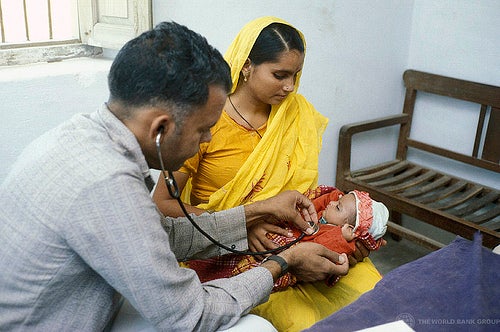
An example of “leapfrogging” in development was in evidence last week at the World Bank’s headquarters as Nandan Nilekani, co-founder of Infosys, and now the Chairman of the Unique Identification Authority of India, described how India is rolling out its Aadhaar scheme, which intends to issue a unique identification number (UID) to every Indian (more than 1.2 billion people).
Mr. Nilekani stressed that such technology would be less demanded in a more developed country setting, where most births are registered, where identifiers (such as name, address, birthdate, passport numbers) can easily be used to confirm someone’s identification and where a myriad of electronic systems are available to most people to track records, make and receive payments. But World Bank President Jim Yong Kim, who practiced medicine in a setting (the US) where such information often does not come together when needed -- such as when a patient moves from one provider to another -- imagined opportunities for this technology well beyond India.
Why would we need to know that someone is who they pretend to be? How could we use a biometric unique identification system which can be linked to additional data? The health sector in India has started to imagine the uses.
One of the benefits that the central government has included in its effort to automate cash transfer benefits by employing the UID system is an incentive scheme that pays incentives to community workers and mothers to increase the share of pregnant women receiving antenatal care and delivering in a facility. In the state of Karnataka, supported by the World Bank- financed Health Development Project, the Health Department is piloting a system whereby a pregnant woman-- at her antenatal registration-- is signed up for a “no frills” bank account (i.e. an account with a zero balance) and also registered for a UID.
When the baby is delivered, the medical officer triggers a process to automate transfer of the incentive payment. The automated payment system draws data from the Mother-Child Tracking System and her identity -- using the UID -- is verified by state and central-level databases.
The federal-level eHealth group -- which is jointly chaired by the Secretaries of the Ministry of Health and Family Welfare and the Ministry of Communication and Information Technology -- will employ UID integration in electronic health records.
The Federation of Indian Chambers of Commerce and Industry has been working with the Ministry on the development of electronic medical records, which would assist in tracking patients across providers (public and private) using the UID. A detailed plan is under development to protect patient data privacy -- an immediate concern with medical records.
In the state of Kerala, “eKerala”, employs the UID in tracking and managing non-communicable disease patients who require chronic care.
And, the Insurance Regulatory and Development Authority has issued new guidelines applicable to private health insurers, including the numerous government sponsored health insurance schemes implemented through private insurers, requiring the capture of the UID so as to improve data analytics, detect fraud and monitor utilization patterns.
One global public health challenge that could directly benefit from the UID program is tuberculosis. Currently, India accounts for about a quarter of the global tuberculosis (TB) burden, with an estimated 2.2 million new cases and 300,000 deaths every year. In addition, an estimated 100,000 new cases of drug-resistant TB emerge each year.
While progress has been made in ensuring patients in the public sector complete treatment, a new initiative, the Nikshay system, which will be linked to the UID, takes an important step toward addressing the large share of patients who seek care in the private sector by providing a platform (where none existed before) for private providers to report TB cases to the government. This recently became mandatory (i.e. TB is now notifiable), but of course the issue is effective implementation.
The TB program is exploring the idea of providing TB drugs free of cost to private providers who report cases, as an incentive to get all patients registered. If we are able to track patients and ensure they complete treatment, we can stem the epidemic of drug-resistant TB globally.
What we’ve seen in India is just a beginning; it’s exciting to imagine the possibilities for applying UID technology across our work in the health sector worldwide.
Follow the World Bank Health team on Twitter: @worldbankhealth.


Join the Conversation